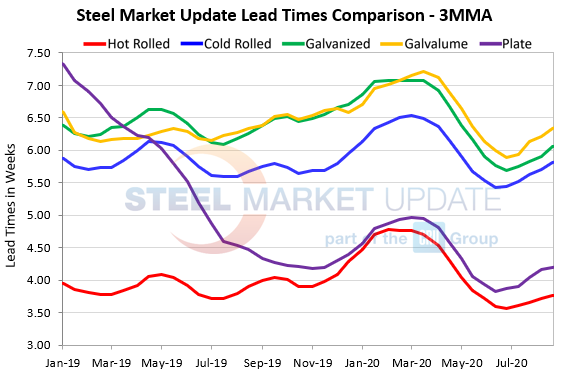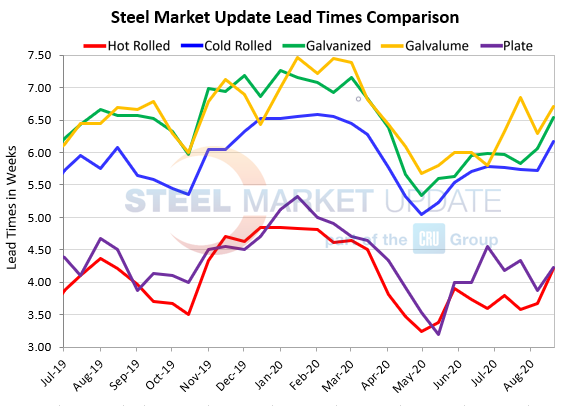SMU Data and Models

Steel Mill Lead Times: Getting Longer
Written by Tim Triplett
August 6, 2020
Lead times for spot orders of flat rolled steel are stretching out as demand improves and the mills get busier. Lead times for hot rolled and plate steels have extended past four weeks, while lead times for cold rolled and coated are now longer than six weeks. Lead times are an indicator of steel demand—longer lead times indicate the mills have more orders to process and are likely less inclined to negotiate on prices.
According to Steel Market Update’s check of the market this week, hot rolled lead times now average 4.21 weeks, up from 3.67 weeks in early August. HR lead times are nearly a week longer than in the trough of the pandemic in late April at 3.25 weeks.
Cold rolled lead times have extended to 6.17 weeks from 5.72 weeks in SMU’s last check of the market. CR lead times dipped to 5.04 weeks in April.
Galvanized lead times have extended to 6.53 weeks, up over a week from the April low point of 5.34. The current average Galvalume lead time is 6.71 weeks. Lead times for coated steel products are about the same as this time last year, pre-pandemic.
Plate lead times bottomed at 3.20 weeks in mid-May and ranged from 4.0 to 4.5 weeks for most of June and July. The latest reading, at 4.22 weeks, is up from 3.88 registered two weeks ago.
Looking at three-month moving averages, which smooth out the variability in the biweekly readings, lead times for flat rolled and plate have continued inching upward for the past six weeks. The current 3MMA for hot rolled is 3.76 weeks, cold rolled is 5.82 weeks, galvanized is 6.05 weeks, Galvalume is 6.33 weeks and plate is 4.19 weeks.
Note: These lead times are based on the average from manufacturers and steel service centers who participated in this week’s SMU market trends analysis. Our lead times do not predict what any individual may get from any specific mill supplier. Look to your mill rep for actual lead times. Our lead times are meant only to identify trends and changes in the marketplace. To see an interactive history of our Steel Mill Lead Times data, visit our website here.


Tim Triplett
Read more from Tim TriplettLatest in SMU Data and Models

SMU Scrap Survey: Sentiment Indices rise
Both current and future scrap sentiment jumped this month, though survey participants reported responses before key trade news was announced.

SMU Survey: Sentiment splits, buyers have better view of future than the present
SMU’s Steel Buyers’ Sentiment Indices moved in opposite directions this week. After rebounding from a near five-year low in late June, Current Sentiment slipped again. At the same time, Future Sentiment climbed to a four-month high. Both indices continue to show optimism among buyers about their company’s chances for success, but suggest there is less confidence in that optimism than earlier in the year.

SMU scrap market survey results now available
SMU’s ferrous scrap market survey results are now available on our website to all premium members. After logging in at steelmarketupdate.com, visit the pricing and analysis tab and look under the “survey results” section for “ferrous scrap survey” results. Past scrap survey results are also available under that selection. If you need help accessing the survey results […]

SMU flat-rolled market survey results now available
SMU’s latest steel buyers market survey results are now available on our website to all premium members. After logging in at steelmarketupdate.com, visit the pricing and analysis tab and look under the “survey results” section for “latest survey results.” Past survey results are also available under that selection. If you need help accessing the survey results, or if […]

SMU Survey: Sheet lead times stabilize, plate contracts
Mill lead times for sheet products were steady to slightly longer this week compared to our late June market check, while plate lead times contracted, according to steel buyers responding to this week’s market survey.

